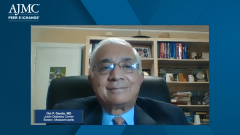
Care Coordination and Treatment Goals in Cardiorenal Metabolic Syndrome
Jeffrey Turner, MD, and Nihar R. Desai, MD, MPH, discuss coordination of care between specialties, and Om P. Ganda, MD, provides insight into the goals of therapy and population health outcomes in cardiorenal metabolic syndrome.
Episodes in this series

Neil Minkoff, MD: I still somewhat think of this as an intern with a background in population health and helping to be a medical director for a hospital network before I got to the payer side. One of the things that we worry or think about is: Who do I send these patients to? Overwhelmingly, a lot of complicated patients are not being taken care of with a team approach, but as a primary care doctor who was in a community hospital setting, should I keep the patient? Should I send them to an endocrinologist, a nephrologist, a cardiologist to see a specialist? Who ends up being the primary caregiver, even in a team approach? Dr Turner, you could talk about your experience there.
Jeffrey Turner, MD: That answer’s probably going to differ across different health systems and different institutions because there’s no standard culture on how to manage these patients that overlap and require specialty care from different providers. The most important thing is that there’s good collaboration amongst the various providers—cardiologists, endocrinologists, and nephrologists working closely with the primary care doctor, together. Speaking specifically to cardiologists and nephrologists, historically, we often worked in siloes. The nephrologist is strictly focused on keeping that creatinine as low as possible and doing everything to optimize that outcome, whereas the cardiologist is doing everything possible to keep the patient decongested and volume unloaded. Sometimes those 2 things work in opposition of one another, so collaborating amongst the different providers is important. At whatever institution this care is going on at, there needs to be an understanding of who’s going to be taking the lead there. I have a clinic that’s dedicated to patients with cardiorenal syndrome. I work closely with our heart failure specialist, so I end up taking care of a lot of those patients and making decisions about everything, from their diuretics to some of their blood pressure medications, even giving themSGLT2 [sodium-glucose cotransporter-2] inhibitors, which I know we’ll talk about more later, as well as other medications to help prevent things. There’s no one single right answer for that, but the main thing is that there’s a collaborative effort going on amongst the various providers.
Neil Minkoff, MD: You have heart failure, which increases morbidity and mortality. You have chronic kidney disease, which increases morbidity and mortality, even premature death and increased hospitalization. How do they impact one another? Were we measuring a bit of overlap already when we were thinking about those disease states? How do you look at the presence of each condition, and how does that complicate the care? Getting at Jeff’s point, sometimes those care plans can feel counterintuitive. Dr Desai?
Nihar R. Desai, MD, MPH: That’s a critical point. We’re lucky that we have such a close collaboration with the nephrologists here at Yale. Jeff leads out those efforts for us, refining the care that is provided to these patients because they require multidisciplinary, multimodality care. Neil, to the point that you were making before, these are some of the most complex patients that we have. The risk that they have from their heart failure or their diabetes or their renal dysfunction is not additive. It’s multiplicative. It’s almost a synergistic set of risk that the patient carries with them because of all the conditions that are interrelated and intertwined. That highlights the need for multidisciplinary care, like Jeff was talking about. These patients are also the highest risk from a utilization and value-based care standpoint. Thinking about how to deliver best care, to deliver value for these patients, is really critical. Neil, you brought up an interesting vantage point because these are the most complex and challenging patients. They’re also the ones that are driving all the utilization and cost, and we have to do better in terms of care coordination along the continuum of care to deliver the best care and outcomes for them.
Neil Minkoff, MD: One of the things that we talk about is how to measure success. How do you measure outcomes? The treatment goals can’t just be these nebulous goals, like improve quality of life or reduce hospitalization. There have to be measurable steps along the way to that. Dr Ganda, could you talk about some of the goals that you see or set for your patients with cardiorenal metabolic syndrome and how you go about trying to get to those goals and measure them?
Om P. Ganda, MD: I think the game is a patient-centered approach. I know it’s a very common term these days that we use, but for the patients where we need to be more aggressive. What are the options? To go back to the previous point, the need to collaborate is bigger than ever before because we have so many better tools of management and so much more knowledge of how these tools work. Then we need to apply them to our practice. We need to work in collaboration with the PCP [primary care physician] who has to deal with so many different problems—whether we’re talking about a cardiometabolic clinic or working with our nephrology friends. We know that our goals are not being met at any level. For example, in the study that have recently been published—the NHIS [National Health Interview Survey] data in the New England Journal of Medicine—a couple of months ago, it pointed out that, over the years, we have not even come close to achieving our goal.
Let’s talk about glycemic goal. Only 55% of patients are reaching the goal of A1C of less than 7%. A little bit better with less than 8%, but the goal is less than 7%, except for certain exceptions in older, frail populations or some patients who have recurrent hypoglycemia. When it comes to lipids, it’s very clear that, in spite of the wide availability of statin therapy, almost all except one are generic, so cost is not a factor. Still, less than 60% of patients are reaching the non-HDL cholesterol goals.
Finally, blood pressure goals. It’s better than what we are achieving with lipid management, but it still depends on how you define the goal for higher blood pressurefor a patient with kidney disease versus a patient who does not have kidney disease. If you look at all of these together, less than 20% or so of patients throughout the country, according to the NHIS data, are achieving all 3 goals. We have a long way to go. Ironically, we have a nice spectrum of various choices to choose from, which are very effective. That’s another reason why there has to be more collaboration; we are not using those therapies as best as we could. How much has changed since 2015, since the first SGLT2 trial was published, after it was presented in Europe? Since then, there have been 8 or 9 GLP-1 [glucagon-like peptide-1] receptor agonist trials. There are 10 different SGLT2 trials in patients with cardiovascular disease or patients with heart failure, as well as patients with kidney disease. Some are still in progress. We have come a long way, but the application of the progress is what we’re talking about and how we need to find a way to come together and be much more collaborative. All the guidelines are now beginning to change that.
Transcript edited for clarity.
Newsletter
Stay ahead of policy, cost, and value—subscribe to AJMC for expert insights at the intersection of clinical care and health economics.





























































